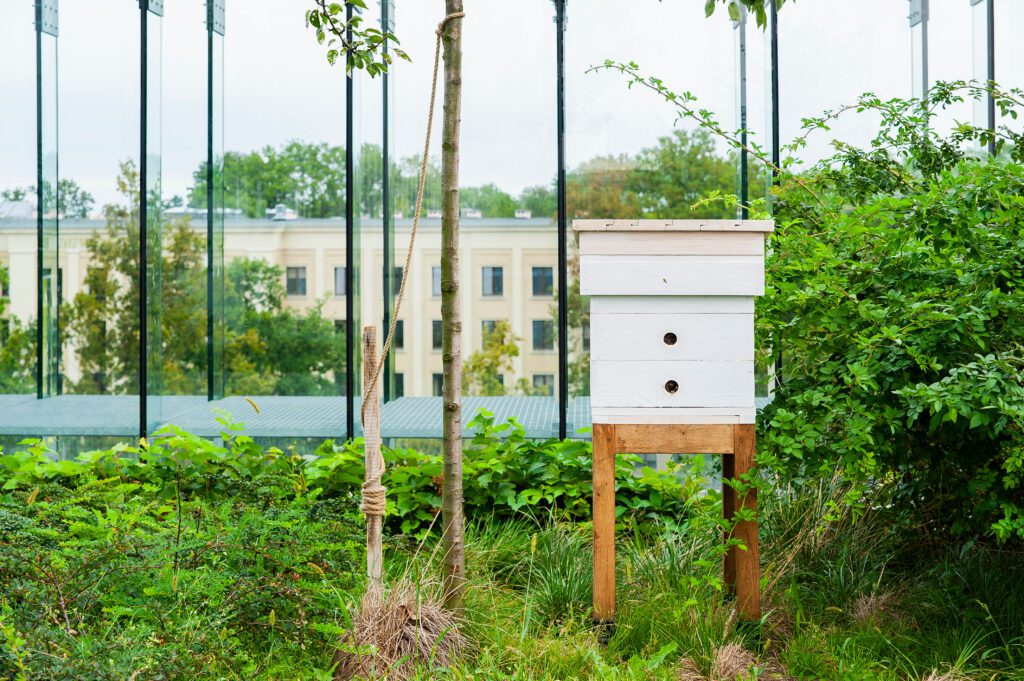Urban Beekeeping: Harvesting Honey in High-Rise Habitats
Embracing Nature in the Concrete Jungle: The Urban Beekeeping Movement
In the midst of bustling cityscapes and towering skyscrapers, a sweet and sustainable revolution is taking place – urban beekeeping. The image of beehives nestled on the rooftops of high-rise buildings might seem paradoxical, but it’s a growing trend that’s making a significant impact on both local ecosystems and communities. Let’s delve into the fascinating world of buzzing metropolises and the delicate dance between bees and city dwellers.
The Rise of Urban Beekeeping
Traditional beekeeping has long been associated with rural landscapes and sprawling fields, where flowers bloom abundantly. However, as urbanization continues to shape our cities, the importance of sustainable practices becomes increasingly evident. Urban beekeeping has emerged as a solution, marrying the needs of both bees and city residents.
In the heart of urban jungles, rooftops have become sanctuaries for beehives. Skyscrapers, typically seen as symbols of modernity and progress, are now playing a crucial role in fostering biodiversity. Bees, with their remarkable adaptability, have found a home amidst the concrete and steel of high-rise habitats.
The Benefits of Urban Beekeeping
1. Pollination in the Concrete Jungle
One of the primary benefits of urban beekeeping lies in the essential role bees play as pollinators. In a city environment, green spaces are often limited, and flowering plants struggle to thrive. Urban beekeepers, through strategically placed hives, enable bees to pollinate a variety of plants, helping to maintain local biodiversity.
2. Honey Production in High-Rise Habitats
The sight of honey bees buzzing around skyscrapers might seem surreal, but it’s a reality that brings a sweet reward – honey production. Urban beekeepers harvest honey from the hives, creating a local and sustainable source of this golden nectar. The unique flavors of urban honey reflect the diverse flowers found in the city, offering a distinct taste that resonates with the local environment.
3. Community Engagement and Education
Urban beekeeping fosters a sense of community engagement and environmental awareness. Beekeeping workshops, community apiaries, and educational programs become avenues for city dwellers to connect with nature and understand the vital role bees play in sustaining ecosystems. This heightened awareness often translates into a greater commitment to environmental conservation.
4. Mitigating Urban Environmental Challenges
Cities face a myriad of environmental challenges, including air pollution, habitat loss, and climate change. Urban beekeeping acts as a small but impactful step towards mitigating these issues. Bees, by pollinating plants and contributing to a healthier ecosystem, help counteract the negative environmental effects associated with urban living.
Navigating Challenges in Urban Beekeeping
While the benefits of urban beekeeping are clear, it is not without its challenges. Bees in high-rise habitats face unique obstacles that require thoughtful solutions.
1. Pesticide Exposure
Urban areas often use pesticides to control pests, and bees can inadvertently be exposed to these harmful chemicals. Urban beekeepers must carefully choose hive locations, considering the types of plants nearby and the potential for pesticide use in the area. Additionally, advocating for pesticide-free urban spaces becomes a crucial aspect of promoting urban beekeeping sustainability.
2. Limited Forage Opportunities
Compared to rural landscapes, urban environments may lack diverse foraging opportunities for bees. Urban beekeepers must work creatively to address this challenge by planting bee-friendly flowers on rooftops, balconies, and other available spaces. Community involvement in creating pollinator-friendly urban gardens can significantly contribute to expanding forage options for bees.
3. Regulatory Hurdles
Navigating urban regulations and zoning laws can be a complex task for aspiring beekeepers. Some cities have strict rules regarding beekeeping, including hive placement and size. Advocacy and collaboration with local authorities are crucial to creating a conducive environment for urban beekeeping.
The Role of High-Rise Habitats and Self Storage in Urban Beekeeping
High-rise habitats provide unique opportunities and challenges for urban beekeepers. Rooftops, balconies, and terraces of high-rise buildings become valuable real estate for beehives. The elevation offers a sense of seclusion for bees, reducing the chances of human interference while providing a haven for pollination.
Self storage properties, with their unused rooftop spaces, also contribute to the urban beekeeping movement. Repurposing these areas for beehives not only utilizes underutilized spaces but also enhances the overall sustainability of such. It’s a win-win scenario where self storage businesses support environmental initiatives while beekeepers find innovative spaces for their hives.
Success Stories of Urban Beekeeping
Numerous cities around the world have embraced urban beekeeping, leading to inspiring success stories.
1. New York City, USA
In the midst of towering skyscrapers, New York City has become a hub for urban beekeeping. Rooftop gardens, community apiaries, and educational programs have flourished, with beekeepers collaborating with local businesses to promote sustainability. The honey produced in NYC carries the essence of Central Park, the High Line, and the city’s vibrant green spaces.
2. Berlin, Germany
Berlin’s commitment to sustainability extends to its beekeeping initiatives. The city encourages rooftop beekeeping, with beekeepers often collaborating with local restaurants and businesses. The Berlin Wall, once a symbol of division, now stands witness to the unifying power of bees as they traverse the city, pollinating plants and creating a sweet legacy.
3. Tokyo, Japan
In the densely populated metropolis of Tokyo, urban beekeeping has found its niche. High-rise buildings, adorned with beehives, contribute to the city’s ecological balance. Tokyoites embrace the concept, with urban beekeeping becoming a popular hobby for residents looking to reconnect with nature amidst the concrete sprawl.
Challenges and Triumphs: Urban Beekeeping’s Evolution
The journey of urban beekeeping is a tale of overcoming challenges and embracing triumphs. As more cities adopt this eco-friendly practice, the collective efforts of urban beekeepers are shaping a sustainable narrative for the future.
Navigating the Concrete Jungle: A Closer Look
Urban beekeepers, armed with passion and purpose, navigate the complexities of the city living. Pesticide exposure remains a pressing concern, prompting the need for heightened awareness and advocacy. As urban environments evolve, so must the strategies employed by beekeepers to create safe havens for their colonies.
Limited forage opportunities, a consequence of urbanization, prompt innovative solutions. Rooftop gardens adorned with an array of bee-friendly plants become oases for bees in search of nectar. Community-driven initiatives to transform unused spaces into pollinator-friendly zones showcase the power of collaboration in overcoming environmental challenges.
Regulatory hurdles, while formidable, are not insurmountable. Beekeepers and city officials can work hand-in-hand to draft regulations that promote urban beekeeping while addressing the concerns of residents. A harmonious relationship between beekeepers and local authorities is pivotal in fostering a thriving urban beekeeping community.
The Growing Role of High-Rise Habitats
High-rise habitats, once symbols of urbanization’s relentless march, are now integral to the urban beekeeping landscape. The elevation provides a unique vantage point for bees, shielding them from some of the disturbances that come with ground-level locations. As more beekeepers turn to rooftops and balconies, the symbiotic relationship between high-rise habitats and bees flourishes.
Self storage properties, often overlooked in discussions of urban ecosystems, emerge as unexpected allies in the urban beekeeping movement. Repurposing unused rooftop spaces not only supports the environment but also showcases the potential of unconventional spaces to promote biodiversity. The self storage industry’s embrace of sustainability aligns with the broader ethos of urban beekeeping, reinforcing the interconnectedness of diverse urban elements.
Tips for Starting Your Urban Beekeeping Journey
If the idea of urban beekeeping resonates with you, here are some tips to get started:
1. Research Local Regulations
Before diving into beekeeping, research local regulations and zoning laws governing urban beekeeping. Understanding and adhering to these guidelines will help you navigate potential hurdles.
2. Choose the Right Hive Location
Selecting the right location for your beehive is crucial. Rooftops, balconies, and terraces are excellent options, providing bees with both seclusion and foraging opportunities.
3. Consider Bee-Friendly Planting
Enhance the foraging options for your bees by planting bee-friendly flowers and herbs in and around your chosen hive location. Create a pollinator-friendly environment that supports the overall health of your bee colony.
4. Collaborate with the Community
Engage with your community and local businesses. Collaboration can lead to mutually beneficial initiatives, such as community gardens, educational programs, and even partnerships with local eateries for honey sales.
5. Educate Yourself
Invest time in learning about beekeeping practices, hive maintenance, and the behavior of bees. Education is key to ensuring the well-being of your bees and the success of your urban beekeeping venture.
Conclusion: Symbiosis in the Cityscape
As urbanization continues to reshape the world, urban beekeeping stands as a testament to humanity’s ability to adapt and find harmony with the natural world. The collaboration between bees and city dwellers in high-rise habitats exemplifies a symbiotic relationship that not only benefits local ecosystems but also enriches the lives of urban communities. Urban beekeeping is more than just harvesting honey; it’s a celebration of nature’s resilience and our shared responsibility to coexist with the environment, even in the heart of the concrete jungle.
The journey of urban beekeeping is an evolving narrative, shaped by the commitment of beekeepers and the growing recognition of the vital role bees play in our urban ecosystems. As cities embrace the buzz of bees amidst skyscrapers, a new harmony is created – one that resonates with the collective heartbeat of a cityscape in harmony with nature. Urban beekeeping, with its challenges and triumphs, offers a glimpse into a future where sustainability and biodiversity are woven into the very fabric of urban life. In the tapestry of the cityscape, bees emerge as ambassadors of balance, reminding us that even in the most unexpected places, the sweet hum of nature can find its home.






